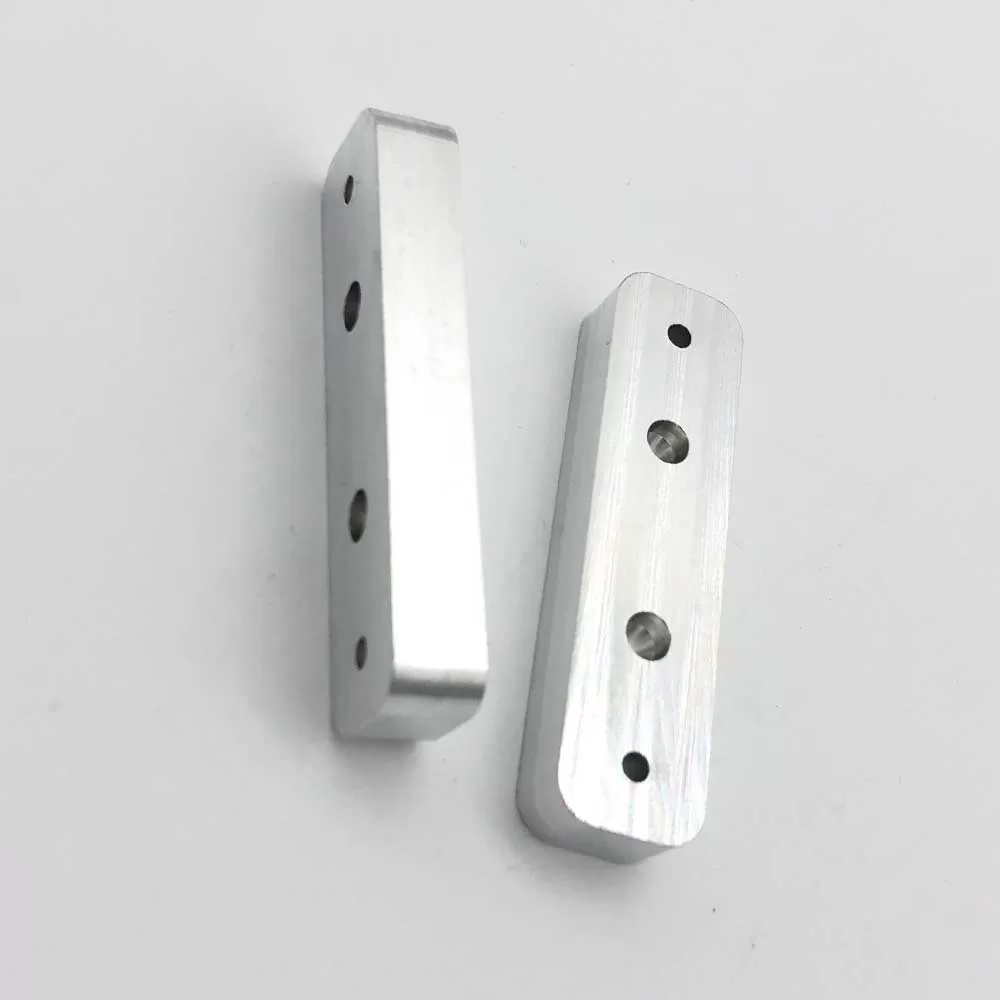
This paper focuses on the CNC mill machining of ultra-slender titanium alloy beam parts. The wool is a die forging, the material grade is TA15M, the outer dimension of the wool is 3500mm×210mm×180mm, and the weight of the wool is 220.5kg. The outer dimension of the part is 3450mm×160mm×151mm, the widest part is 151mm, and the narrowest part is only 34mm. The shape of the part is a complex hyperboloid, double-sided cavity, and the minimum thickness of the edge and the web is only 2mm. Dimensional accuracy and surface quality requirements are high.
Determine the CNC machining process plan
The rough material of ultra-slender titanium alloy parts is TA15M free forging, and the residual stress of forgings leads to the deformation of parts during mill machining. Parts are extra long and narrow, with aspect ratios ranging from 22.8-101.5. Most of the structural surfaces of the parts are curved surfaces with variable angles, and all the edges are sloped, so the clamping and positioning are not reliable. The thickness of the flange and the web is thin, the minimum is 2mm, and the tolerance is ±0.2mm. The edge is high and the angle is large, the highest point is 96mm. The assembly relationship of the parts is complex, and there are parts assembled with it at every position of the beam. The surface quality requirements are high, and the roughness of all corners and bottom corners is 1.6 μm. The part structure belongs to the structure type with extremely poor manufacturability. The problems to be solved in the processing include: the control of deformation during mill machining, the selection of clamping and positioning methods and shortening the processing cycle.
Part positioning method
During the processing of ultra-slender titanium alloy beams, the choice of positioning method is very important. The beam is long and thin, and has a groove structure on both sides, so it is positioned by edge strips. Since the direct positioning of the part using the beveled edge strip will greatly reduce the accuracy of the positioning surface and greatly affect the processing quality of the part, so setting the process boss on the edge strip for positioning can not only ensure the accuracy of the positioning reference, but also avoid processing During the process of frequent inverted plate work. The distance of the process boss should be appropriate, if it is too close, it will increase the frequency of tool jumping in the process of processing, and increase the difficulty of removing the process boss; if the process boss is too far away, the positioning will be unstable, and the deformation of the part during mill machining will be increased chance, reducing positioning accuracy. According to the structural characteristics of the beam, a stepped process boss is used, and then two process holes are drilled on the beam body for joint positioning. The hole diameters are 25H9 and 12H9 respectively, and the positioning is stable and reliable. The shape of the process boss is shown in the figure above.
Selection of machine equipment and tooling
The ultra-slender titanium alloy beam is about 3.5m long, the head of the part is raised, and the tooling is huge. The height of the part plus the tooling exceeds 500mm, so the Z-stroke travel of the machine tool used must be about 700mm. Through the inspection of the machine tool on site, the size of the machine tool table is 3500mm×1250mm, the range of swing angle is A±30°, B±30°, the precision of the machine tool is high, and it can meet the processing requirements of the parts.
The processing of ultra-slender titanium alloy beam adopts the high-tech boss of the edge strip and the positioning method of the reference hole of the beam body. The head adopts auxiliary adjustable support, which is used to correct the deformation of the head and remove the deformation during processing; the pressing plate adopts the Z-shaped pressing plate, which can effectively reduce the length of the tool, avoid the interference between the machine tool and the tooling, and improve the processing efficiency and ensure the parts The surface roughness after processing; tooling increases the use of check blocks to verify the program during processing, and to avoid parts out-of-tolerance and waste products caused by workers using wrong tools, which improves the probability of successful product processing at the first time. One set of tooling is required for each front and back processing. There are nearly 300 guide holes on both sides of the ultra-slender titanium alloy beam flange. If the traditional method is used, the conventional processing is very difficult, time-consuming and laborious, and the product quality is not easy to guarantee. Using CNC machine tools to drill pilot holes saves time and effort and ensures product quality. The use of CNC drilling guide holes requires higher tooling requirements. One set on each side of the bead.
Determine the CNC milling process
The reasonable arrangement of the processing flow is an important link in the production and development of parts, and the rationality of the processing flow is an important reason for the deformation of parts. The order of the processing process directly determines the way, size and sequence of the parts to be measured, which will affect the stress release of the part material, as well as the deformation size and deformation mode of the part. Reasonable processing flow can greatly reduce the chance of deformation of parts. The mill machining process should not only consider the deformation factors of the parts, but also ensure the dimensional accuracy of the parts. According to the parts characteristics of ultra-slender titanium alloy beams, the processing flow of parts is formulated: die forging incoming material—milling datum plane—boring datum hole—behind rough milling (leave 7mm allowance)—rough milling front (leave 7mm allowance) )—front of rough milling (leave 3mm allowance)—behind rough milling (leave 3mm allowance)—one side of rough milling groove (leave 3mm allowance)—other side of rough milling groove (leave 3mm allowance)—measurement Shape and notch—semi-finish milling shape (leave 1mm margin)—semi-finish milling front (leave 1mm margin)—semi-finish milling rear (leave 1mm margin)—measure shape and intersection hole—finish milling notch —Finish milling shape—Measuring shape and notch—Finish milling inner shape before—Finish milling inner shape—Measuring hole position, etc.—CNC drill edge guide hole—Milling process boss—Fitter drill rib guide hole—Half Inspection—cleaning—fluorescence inspection—sand blowing—marking—complete inspection—delivery. Through multiple continuous turning processes and gradual reduction of the amount of removal, the deformation of the parts can be effectively eliminated and the product quality can be guaranteed.
Tool selection and parameter determination
CNC mill machine tools are cooled by coolant, combined with the titanium alloy material of the parts, shallow cutting tools and integral alloy straight shank end mills should be the main ones, supplemented by inlaid alloy tools. Since titanium alloy is a difficult-to-machine material, the quality and performance requirements of the tool are very high. The tool processing parameters are determined according to the existing parameter library and the actual processing conditions of the parts. The main cutting parameters in cutting are: spindle speed n, cutting depth ap, cutting width ae, feed per tooth fz, number of tool teeth Z and feed speed vf, where vf=nZfz. The number of teeth of the titanium alloy processing tool is generally a multi-tooth tool, and most of the tools used in processing this part are 4-tooth tools. The main parameters that affect the machining efficiency of the tool are the number of revolutions of the spindle (n) and the feed per tooth of the tool (fz). Table 1 shows the specifications and processing parameters of the main tools involved in processing.
Compilation of CNC programs
According to the deformation control of parts, the state of incoming materials, the structural characteristics of parts, the characteristics of machine tools, the characteristics of cutting tools, etc., the CNC mill machining program is compiled. It is necessary to effectively avoid some common problems when programming: ① avoid redundant tool paths and reduce unnecessary jumping; Layered processing in the direction and axial direction ensures that the cutting allowance of the tool is uniform and reduces the loss of the machine tool and the tool; ④ Avoid vertical contact between the tool and the part; ⑤ Reduce the processing speed at the corner. , Special corners (such as the inner rib corner of the process boss) should reduce the speed by 20%. Guarantee normal cutting without manual intervention; ⑥Clear the corner before finishing to ensure uniform milling amount of finish milling; ⑦Correctly calculate the R shrinkage value. The way the program moves can also affect the deformation of the part. For example, shallow cutting and down milling can greatly reduce the deformation of the part. Shallow cutting can not only greatly increase the metal removal rate, but more importantly, it can reduce the cutting force and processing stress, which is conducive to reducing the deformation of the parts during processing, and can also reduce the load of the machine tool and protect the CNC machine tool. The special processing tool used for shallow cutting has high processing efficiency. Taking the D20R4 tool as an example, the feed speed can reach 1432mm/min. Compared with the ordinary tool rough milling feed rate of 60mm/min, the efficiency can be higher Several times or even ten times. Shallow cutting is especially suitable for rough mill machining of ultra-slender titanium alloy beams. Use the “roughing” command to compile a shallow cutting program. In the process of semi-finishing and finishing, the radial layering method is adopted, and the feed rate of each layer is 0.5. On the premise of ensuring the accuracy of the parts, the cutting stress can be greatly reduced and the parts can be reduced. amount of deformation.
Summarize
A set of reasonable process plan is suitable for ultra-slender titanium alloy beam parts. The deformation of the part is effectively controlled by methods such as stress release, optimized cutting method and reasonable tool parameters. The method of positioning the process boss also plays a good role. positioning effect. The program has passed the processing verification and achieved very good results in actual processing, and finally produced qualified parts with stable processing and qualified product quality.

